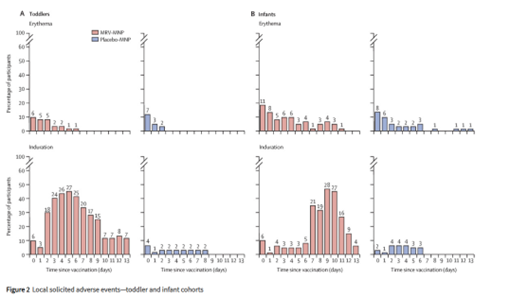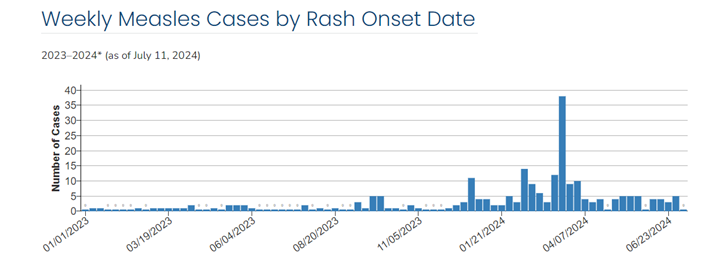Vaccine Update: Microneedle Patches May Help Overcome Immunization Barriers
Column Author: Yvonne M Carter, MSN, APRN II, FNP-C
Column Editor: Angela L. Myers, MD, MPH | Division Director, Infectious Diseases; Medical Director, Center for Wellbeing
A study conducted in Gambia published in The Lancet earlier this year highlights a revolutionary approach to routine childhood vaccinations, particularly in low-income and middle-income countries. According to scientists, microneedle patches (MNPs) are considered a global priority innovation for overcoming immunization barriers. The single-center, phase ½, double-blind, double-dummy, randomized, active-controlled, age de-escalation trial aimed to provide the first safety, tolerability and immunogenicity data of a measles and rubella vaccine microneedle patch (MRV)-MNP in children.1
From May 2021 to May 2022, the study enrolled 45 adults age 18-40 years, 120 toddlers age 15-18 months, and 120 infants age 9-10 months. Participants were randomly assigned at a 2:1 ratio (adults) or 1:1 ratio (toddlers and infants) to receive either MRV-MNP and a placebo subcutaneous injection, or a placebo-MNP and an MRV subcutaneous (MRV-SC) injection. The immunogenicity population consisted of all vaccinated participants who had a baseline visit and a day 42 visit result with no protocol deviations that could affect immunogenicity endpoints. Serum neutralizing antibodies to measles and rubella were measured at baseline, day 42 and day 180. In infants, 93% seroconverted to measles and 100% seroconverted to rubella following MRV-MNP administration, while 90% and 100% seroconverted to measles and rubella following MRV-SC. 1
The safety population included all vaccinated study participants. Solicited local and systemic adverse events were collected by study staff for 14 days following participants’ vaccination. Unsolicited adverse events were recorded up to day 180 of the study. Between each age cohort, age de-escalation was based on the review of safety data through day 14 by an independent monitoring committee. Of the adverse reactions reported, mild local reactions were the most common (Figure 1). Induration at the MRV-MNP application site occurred in 77% of toddlers and 65% of infants who received it. Additionally, discoloration of the application site was reported in 58% of toddlers and 95% of infants who had received the MRV-MNP. Pruritis was reported as an additional adverse event in the adult cohort. No severe or serious adverse effects were determined to be related to MRV-MNP.1
Figure 1: Local solicited adverse events—toddler and infant cohorts

(https://www.thelancet.com/journals/lancet/article/PIIS0140-6736(24)00532-4/fulltext)
As with most vaccines, systemic adverse events for adults included fever, vomiting, diarrhea, headache, fatigue, myalgia, arthralgia and rash. For infants and toddlers, recorded systemic effects in the first 14 days included fever, vomiting, diarrhea, irritability, drowsiness, reduced appetite, and rash. There were no acute allergic reactions in adults, toddlers or infants. Fever did occur in eight infants of the MRV-MNP cohort, as opposed to four infants in the MRV-SC cohort. Of toddlers, five experienced fevers following MRV-MNP, as opposed to 11 fevers in those who received MRV-SC. No infant or toddler fevers were severe, and no adverse effects categorized as severe or serious were determined to be related to MRV-MNP.1
Both the MRV-MNP and the MRV-SC used in the study contained live-attenuated measles and rubella virus. For the MRV-MNP, the bulk vaccine viruses were incorporated into dissolvable microneedles designed to deliver similar doses as subcutaneous injection. The patches were applied to the dorsal aspect of participants’ wrists for five minutes before being removed.1 For those with needle-phobia, or for parents who may have difficulty subjecting their child to painful injections, this vaccine delivery system has the potential to revolutionize pediatric health care. As of July 2024 in the United States, 13 measles outbreaks have already been reported, with 66% of all cases (110 of 167) determined to be outbreak related. Of the total 167 cases as of July 11, 46% are under the age of 5, 84% are unvaccinated or with unknown vaccination status, and 53% have been hospitalized for isolation or management of measles complications. Patients under the age of 5 make up the largest portion of those hospitalized. For comparison, only four outbreaks were reported the entirety of 2023, with just 48% of cases (28 of 58 total) related to outbreaks.2 (Figure 2).
Figure 2: Weekly Measles Cases by Rash Onset Date, from 2023-2024

(https://www.cdc.gov/measles/data-research/index.html)
New methods are needed to achieve elimination of vaccine-preventable diseases. While microneedle drug delivery was first mentioned in medical literature over a century ago, the concept was not demonstrated experimentally until the 1990s. Over the years, researchers explored different materials to fabricate microneedles and allow for transdermal drug delivery. In 2005, the first reports of a dissolvable microneedle being used were published. Most recently, the use of commercially available 3D printers to fabricate master molds for MNPs has allowed for low-cost solutions to large-volume manufacturing of microneedle drug delivery systems. Along with the data from this recent study, this development makes way for expansive opportunities in the realm of immunization delivery worldwide and may prove instrumental in achieving equity in access to vaccines for low-income and middle-income countries.3
References:
- Adigweme I, Yisa M, Ooko M, et al. A measles and rubella vaccine microneedle patch in The Gambia: a phase ½, double-blind, double-dummy, randomised, active-controlled, age de-escalation trial. Published online April 29, 2024. doi:10.1016/S0140-6736(24)00532-4
- Measles cases and outbreaks. Centers for Disease Control and Prevention. Last reviewed July 11, 2024. Accessed July 18, 2024. https://www.cdc.gov/measles/data-research/index.html
- Aldawood FK, Andar A, Desai S. A comprehensive review of microneedles: types, materials, processes, characterizations and applications. Polymers (Basel). 2021;13(16):2815. PMID: 34451353. PMCID: PMC8400269. doi:10.3390/polym13162815
